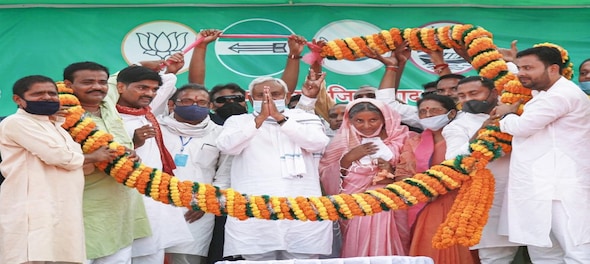
As the battle in Bihar enters the final stage, it is becoming increasingly clear that while the COVID-19 fears regarding the voter turnout have died down, all the political parties have swiftly adapted to digitally interacting with the voters along with traditional modes of campaigning. Which political party has an advantage in new ways of campaigning in Bihar 2020?
We analysed the advertising pattern, spending on digital advertisements, the contents of advertisements on a variety of parameters like tone and type of issues among other for all the political parties (except RJD) collected by the DigiCamp Project at the National University of Singapore (NUS), the data for which is publicly available for the period from—August 01, 2020—till the first phase of elections—October 28.
Will social media management and advance advertisement strategies followed by the incumbent JD(U)-BJP alliance help Chief Minister Nitish Kumar in winning his fourth consecutive term in the office—a rare feat in the Indian elections?
First, the data suggest NDA allies are among the front runners in terms of spending on advertisements. The ruling Janata Dal-United has spent around Rs 5 million on political advertising between August 01, 2020, and October 29, 2020. JDU’s alliance partner, the BJP spent Rs 4 million for the same duration. The Indian National Congress, the poll partner of Tejaswi Yadav’s RJD, stands third in the tally with just over Rs 3 million.

Second, a closer look at the week wise data indicates that the BJP spending decisions are very strategic in nature—they know the right time to push the campaign gear on digital platforms. BJP spent almost double than the Congress last week to the first phase of polling. JDU, on the other hand, spent more in September than in October on digital platforms.

Third, as our colleague Illika Trivedi pointed out last week, the NDA is banking heavily on the women voters to beat the anti-incumbency sentiments against CM Nitish Kumar. The importance of the women votes gains more salience in this election as 5,15,800 new female voters have been added to the electoral rolls vis-a-vis 3,49,663 male voters. The NDA’s spending pattern supports this claim and the same is visible in their advertisement pattern. The JDU-BJP combine has spent almost double than the Congress in targeting women voters.

Fourth, while the spending and number of advertisements matter, the content of the advertisement is of greater importance as it gives the voters a general impression about issues the party stands for and the narrative it is using to influence voters. With the stricter norms on political advertisement by social media, parties really have to be cautious about the content, sentiment and factualness in their advertisement.
These advertisements can be classified into negative, positive, and neutral, and also as uncivil and civil. Contrary to the received wisdom, our analysis suggests that the campaign has largely been positive. With the ruling alliance having the highest money spent, more than 80 percent on ads that can be classified into positive and civil, the ads which are negative are negligible. We also looked at emotions these ads evoke such as happiness, pride, enthusiasm, hope, worry, sadness, disgust and anger.
Not surprisingly, both JDU and BJP have spent a greater portion on ads which have been classified as evoking happy and hopeful emotion. This is in line with the argument that the incumbents most often tries to paint a happy and hopeful picture, and the opposition invokes negative emotion (sadness and anger). Furthermore, we found that one-third of the money is spent by parties on the personalisation of the campaign. Again, not surprising given the leader-centric nature of Indian elections.
Fifth, we also analysed the top 500 ads based on the number of impressions, which is defined as the number of times content was displayed on someone’s social media feed. We find that the economy has held the top spot for all the parties except JDU which has Governance at the top. Crime, law and order which has been the JDU’s main campaign issue since 2005, it can be seen that ads raising this issue are highest in JDU (15 percent) as compared to other parties.

The Bihar 2020 is undoubtedly the litmus test for CM Nitish Kumar as he is trying to gather support on its ‘Sushan Babu’ image, while facing intense anti-incumbency and being cornered on several fronts—from economic, law and order to mishandling of the migrant crisis. The NDA seems to be way ahead in the social media battle, but we will find out on November 10 whether the voters would reward Nitish Kumar with the fourth consecutive term.
—Jatin Rajani and Talha Rashid are research associates at the Centre for Policy Research, New Delhi. The views expressed are personal
(Edited by : Ajay Vaishnav)
First Published: Nov 5, 2020 5:34 PM IST
Check out our in-depth Market Coverage, Business News & get real-time Stock Market Updates on CNBC-TV18. Also, Watch our channels CNBC-TV18, CNBC Awaaz and CNBC Bajar Live on-the-go!


Lok Sabha Election 2024: Phase 5 voting concludes with over 57% voter turnout, experts weigh in on key battles
May 20, 2024 11:07 PM
BJP holds meeting in Delhi as polling underway for 5th phase
May 20, 2024 4:21 PM
UP Police arrests man after viral videos shows him voting multiple times
May 20, 2024 2:18 PM

